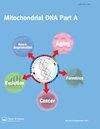绵羊线粒体异质性是由串联基序和非特异性PCR扩增引起的
IF 0.6
4区 生物学
Q4 GENETICS & HEREDITY
引用次数: 5
摘要
线粒体DNA控制区(D-loop)是一种广泛应用于进化和系统地理学研究的分子标记。然而,个体内D-loop区域异质性的发生鲜有研究。本研究利用85只中国绵羊扩增部分D-loop区,鉴定出15只异质动物(占17.64%)。通过对异质区D-loop序列的PCR扩增和克隆比较分析,发现大部分异质区序列图谱都是从一个75-bp的随机重复基序开始的。此外,从4只随机异质动物和3只纯合子动物中获得的61只克隆中,共发现22条带有d环的非同源序列,并对其基因组位置进行了同源性比较。总之,D-Loop测序谱似乎是异质性的,可能是由串联重复基序和PCR扩增过程中的非特异性复制引起的;然而,它们不太可能是由于个体内存在多个线粒体基因组。本文章由计算机程序翻译,如有差异,请以英文原文为准。
Sheep mitochondrial heteroplasmy arises from tandem motifs and unspecific PCR amplification
Abstract The mitochondrial DNA control region (D-loop) is a widely used molecular marker in evolutionary and phylogeographic research. However, the occurrence of heteroplasmy of the D-loop region within individuals has rarely been investigated. In this study, a total of 85 Chinese sheep were used to amplify a partial D-loop region, and 15 heteroplasmic animals (17.64%) were identified. A comparative analysis of the PCR amplification and cloning of the D-loop sequences from the heteroplasmic samples revealed most of the sequencing profile from the heteroplasmic regions started at the beginning of a 75-bp random repeat motif. In addition, a total of 22 nonsyngeneic sequences with a D-loop were found in 61 of the clones obtained from the 4 random heteroplasmic and 3 homozygote animals, and their genomic locations were compared for homology. In summary, the D-Loop sequencing profiles appear to be heteroplasmic and could arise from tandem repeat motifs and unspecific replication during PCR amplification; however, they are not likely due to the presence of multiple mitochondrial genomes within an individual.
求助全文
通过发布文献求助,成功后即可免费获取论文全文。
去求助
来源期刊

Mitochondrial Dna Part a
Biochemistry, Genetics and Molecular Biology-Genetics
CiteScore
3.00
自引率
0.00%
发文量
6
期刊介绍:
Mitochondrial DNA Part A publishes original high-quality manuscripts on physical, chemical, and biochemical aspects of mtDNA and proteins involved in mtDNA metabolism, and/or interactions. Manuscripts on cytosolic and extracellular mtDNA, and on dysfunction caused by alterations in mtDNA integrity as well as methodological papers detailing novel approaches for mtDNA manipulation in vitro and in vivo are welcome. Descriptive papers on DNA sequences from mitochondrial genomes, and also analytical papers in the areas of population genetics, phylogenetics and human evolution that use mitochondrial DNA as a source of evidence for studies will be considered for publication. The Journal also considers manuscripts that examine population genetic and systematic theory that specifically address the use of mitochondrial DNA sequences, as well as papers that discuss the utility of mitochondrial DNA information in medical studies and in human evolutionary biology.
 求助内容:
求助内容: 应助结果提醒方式:
应助结果提醒方式:


